Contents


Almost everyone knows how to plant potatoes. There is nothing complicated here: I dug a hole, put a tuber and buried it – let it grow. But I want the harvest to be larger, and the tubers are larger, and therefore summer residents are trying to choose the most effective potato planting scheme. They plant it manually, under a shovel, in trenches or on ridges, use a walk-behind tractor or a potato planter – each scheme has supporters and opponents. But a good result with any scheme depends on the climate, planting material, planting dates, hole depth, row spacing, and so on. Therefore, the technology that you have adapted specifically to your site will be effective. Let’s talk about some of them.
Ridge landing pattern
This method is very successfully used in Holland, getting high yields. The fact is that high hilling allows the root system to develop freely and form many tubers. In addition, planting in ridges facilitates plant care and allows the use of small-scale mechanization when processing a potato field. The advantage is that the soil in the ridges in the spring warms up faster and better than on flat ground – which means you can start planting earlier. Such a planting scheme is more appropriate in places where groundwater is close: the comb will not allow the tubers to rot.
The Dutch method is used in waterlogged areas or in areas with heavy soil.
Before planting potatoes on the ridges, fertilizer and ash are applied to the soil. The beds are dug up so that everything is mixed with the ground. Then, with a chopper, tractor or motor cultivator, ridges up to 15 cm high are made and germinated tubers are laid out in them 25-30 cm apart. The distance between the combs is 70 cm.
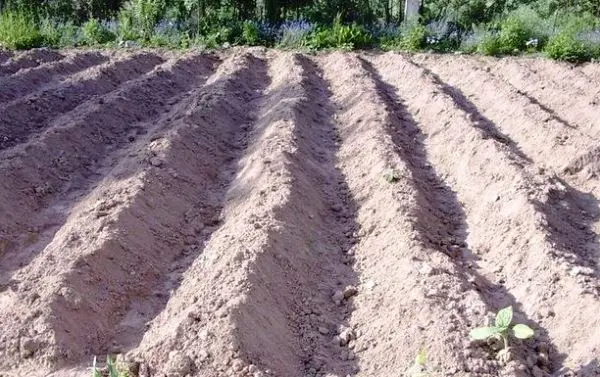
Wide paths are obtained between the ridges, so there is free access to the plants and it is easy to loosen the soil and hill the plants.
Potatoes are well blown, receive a lot of sunlight, as the plants are raised above the ground.
After the emergence of seedlings, the plants are sprinkled with earth from the aisles. And when they rise to 7-10 cm, they need to be treated with a solution of potassium permanganate (2 g of crystals per bucket of water). And at the same time, liquid organic fertilizer is applied for top dressing.
In rainy weather, potato tubers planted on ridges do not rot, because water does not accumulate on a high ridge, but rolls down. If the weather is dry, then the potatoes need additional watering.
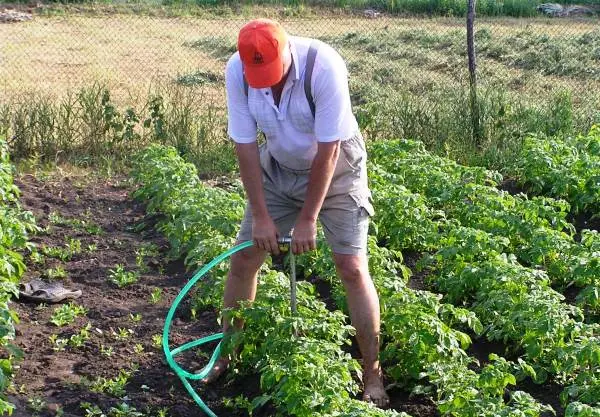
How to plant under a shovel
Potatoes are planted under a shovel on the south side, where the planting site is flat, the soil is loose and moisture-intensive, the soil warms up quickly, and the area is evenly illuminated by the sun. In this way, it is easier to plant potatoes together: one makes holes along the marked lines, the second lays out sprouted tubers. Some gardeners lift a layer of earth and lay tubers under it.
This method is applicable when developing a new site. In this case, the freshly plowed sod must be turned upside down.
On clay soils, it is better not to use this method, since such soil does not pass water well, becomes dense after rain, and air access to the roots is difficult.
Experts recommend planting potatoes at a distance of 60-70 cm between rows, depending on the variety. The planting depth depends on the type of soil and ranges from 4-5 cm on clay soils to 10-12 cm on light soils. Large tubers are planted deeper than small ones. The distance between the tubers depends on their size and ranges from 25 to 35 cm.
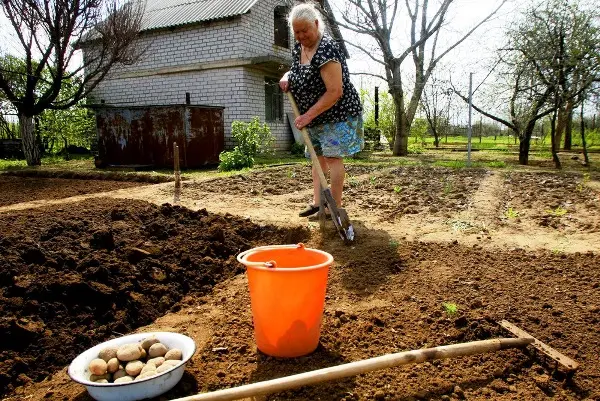
Landing pattern in trenches
This method of planting potatoes is remarkable in that in this case chemical fertilizers are not needed, the plants receive heat and natural feeding, and soil fertility improves. Therefore, it is better to use it in areas with loose soil that does not retain moisture well. Planting potatoes in trenches allows you to deepen the tubers and protect them from overheating and drying out in hot climates.
Preparing trenches for planting potatoes begins in the fall. First, trenches are dug at a distance of 60-80 cm, the depth and width of which is 35-40 cm (with a spade bayonet). The excavated earth is left next to the groove in the form of a ridge. Organic remains are laid at the bottom of each of the ruts: grass, weeds, tops of zucchini and cucumbers, onion peel, food waste and even paper. Tops of tomatoes and potatoes should not be laid in trenches. When the leaves fall, they are added to the potato grooves and covered with earth.
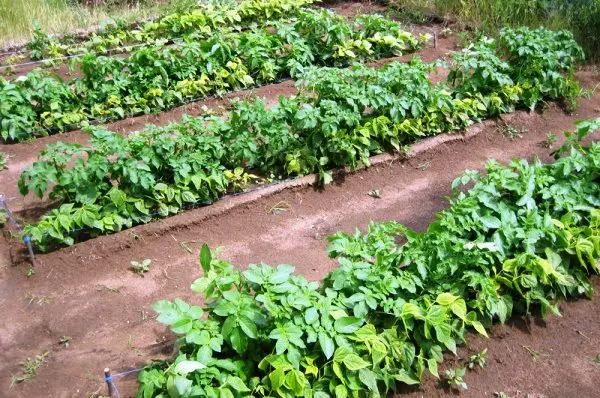
Potatoes are planted in trenches when lilacs bloom. During the winter, the litter settles, and a little earth is sprinkled on top. Dry chicken manure, onion peel and ash are added to the trench, sprouted potatoes are laid out every 30 cm and covered with earth from the comb. When shoots appear, they need to be sprinkled with earth to protect them from frost. As the bush grows, it is sprinkled several times. Potatoes are spudded and a bed is formed for planting next year: the ridge turns into a groove, and a ridge is obtained in place of the groove. After harvesting, the trenches are deepened and filled with organic fertilizers.
Planting potatoes with seedlings
If you want to get very early potatoes, plant them in seedlings. In addition to an early harvest, this method will give an increase in yield up to 40% and will save planting material.
Seedlings are grown from healthy varietal tubers, which are germinated in the light for a month, and then planted in boxes or in small pots with a peat mixture. When the plants grow up to 7-10 cm (it will take about three weeks), they, along with the tubers, are selected and transplanted into the holes. The distance between the holes is 20-25 cm, between the rows – 50 cm. The tubers are planted at such a depth that the tops remain above the soil. Seedlings are planted in ridges, and in trenches, and under a shovel – it all depends on the conditions in your area.
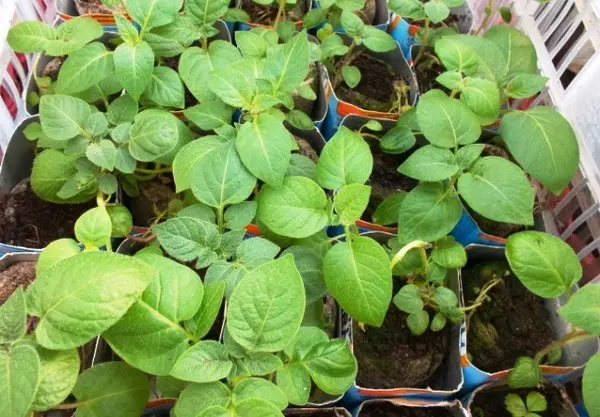
To get a good potato harvest, you need to consider many things. And the potato planting scheme must be chosen according to your conditions. Any of them is applicable in certain conditions and may be effective in your area, but not justify itself elsewhere.
Video “Methods of planting potatoes”
The video is about different ways of planting potatoes; review of methods, features of application on different soils, etc.









